A NIGHTMARE ON ELM STREET: 7-Film Collection (1984-1994)
All seven Nightmare on Elm Street movies collected together on 4K Ultra HD Blu-ray...
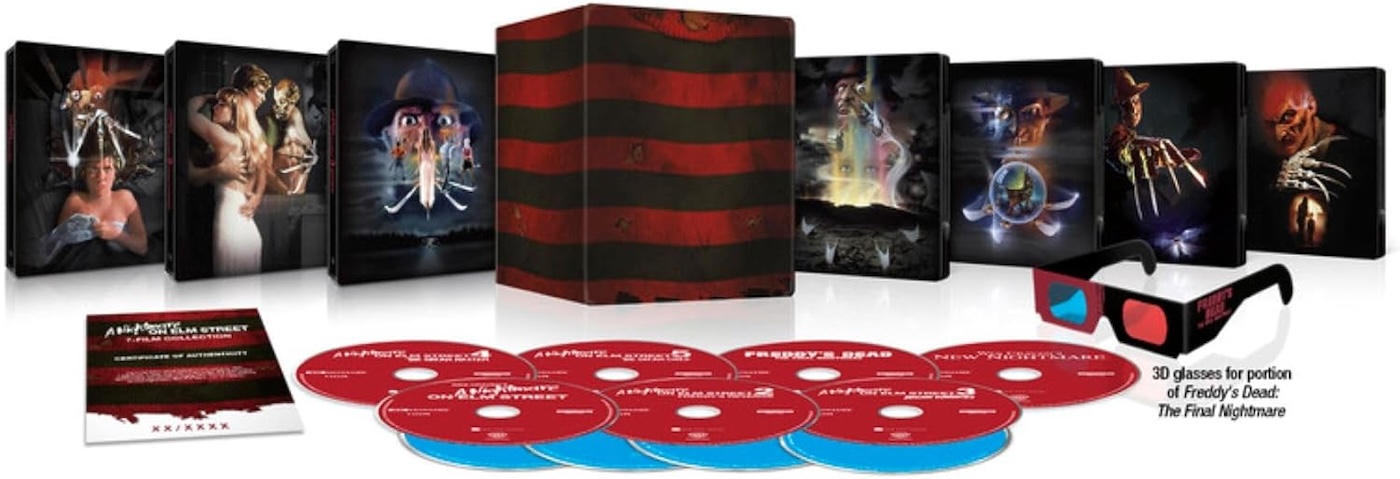
All seven Nightmare on Elm Street movies collected together on 4K Ultra HD Blu-ray...


It’s been over 40 years since Wes Craven wrote and directed A Nightmare on Elm Street (1984), his seventh film and fourth horror. Having felt pigeonholed into the genre, he recalled, “It soon became clear that [he] wasn’t going to do anything else unless it was scary.” Compelled by his own troubled dreams, he couldn’t help but develop his next slasher, one unlike the mute, masked maniacs of Michael Myers and Jason Voorhees. Freddy Krueger (Robert Englund) could talk, taunt, mock, and berate his victims because he could do whatever he wanted. Their nightmares were his playground.
It was smash hit so culturally resonant the near-bankrupt New Line Cinema was forever known as ‘The House That Freddy Built’. And people knew exactly who that Freddy was. He went by ‘Fred Krueger’ at first but soon became a 1980s pop-culture icon as familiar as Madonna or Prince. The undead child murderer had his own 9-0-0 number, hosted a 44-episode anthology show (largely unrelated to nightmares), and starred in his own MTV music videos. A winning personality set him apart from the silent slasher antiheroes—even subsequent smart-mouthed killer doll Chucky was indebted to Freddy. What’s incredible looking back four decades is that Freddy Krueger’s last feature-length role was two decades ago now, and his last mainline entry in this collection was released three decades ago. Freddy Krueger was the coolest killer in the world, but for all of a single decade, and it took two more films for New Line Cinema to officially declare him dead.
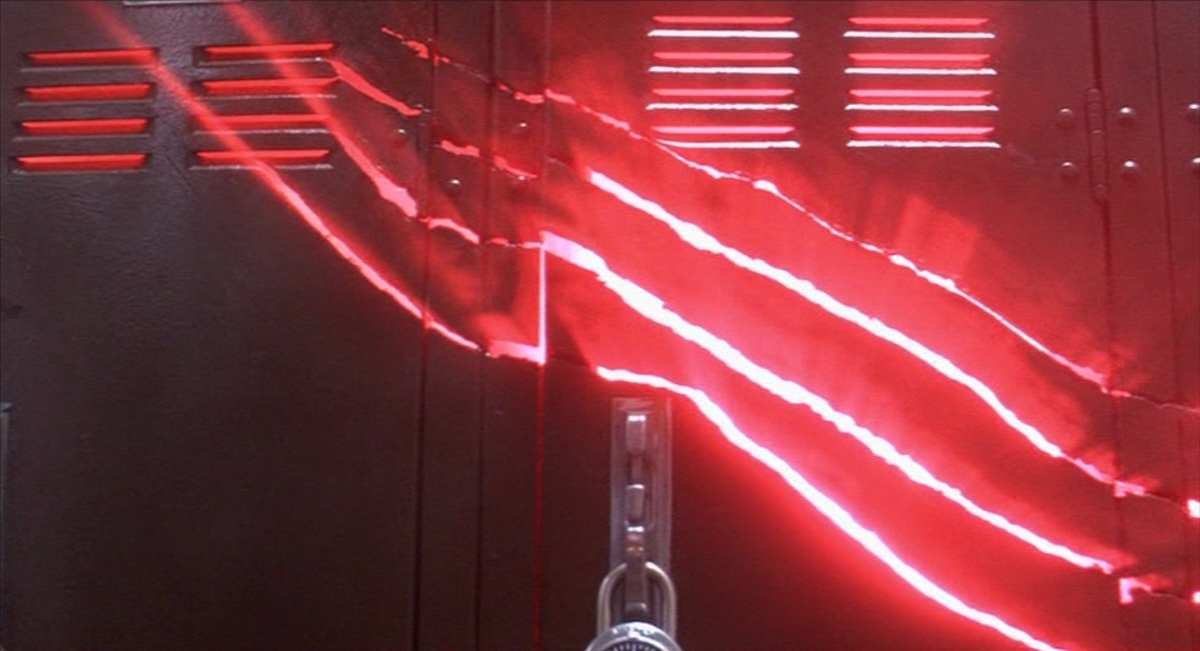
Craven passed away in 2015 with no interest in returning to NOES given his more recent success with the Scream horror franchise. Robert Englund has also made it clear he’s too old to reprise the role, at least in full physical make-up. And the only major attempt to revive the IP, with Jackie Earle Haley as Freddy, in the 2010 update, seemed to mark the moment 2000s audiences were done with horror remakes. Chucky’s TV show was just cancelled, but creator Don Mancini wants to make another movie; Michael Myers got killed off, but the rights have been sold for yet another reboot; even Jason Voorhees, who hasn’t been seen in 20 years, has a new prequel TV series in the works. But none of them are quite as dead as Freddy.
Still, we don’t need new nightmares because the old ones are as enjoyable today, even more so in stunning 4 Ultra HD. There are two new featurettes starring the cast and crew, and those people have been expressing their gratitude in seeing their work so lovingly restored in this box set. For a dead franchise, their reverence has never faded. In perfect timing, Englund is receiving his Walk of Fame star this Halloween. While the actor-director’s done so much over the years, one could award an entirely separate star just to Freddy Krueger himself.. but I’m sure he’ll settle for this fantastic 7-film box set.


Teenagers in a small town are dropping like flies, apparently in the grip of mass hysteria causing their suicides…
I’ve seen this movie many times; alone as a child, with friends, and while listening to the rap album Freddy’s Greatest Hits trying to absorb the experience afresh. When a sadistic killer now comes with his own board game it can be hard to separate the source material from the cultural zeitgeist (a phenomenon Craven would respond to with 1989’s Shocker). But when the original Elm Street starts with those grubby hands constructing his iconic bladed glove—the weapon of a modern “predatory animal” as Craven described it—you immediately feel alone with Tina (Amanda Wyss) down in that hellish basement.
If fully appreciating Wes Craven’s original masterpiece is as unavoidable as a good night’s sleep, you can read our full A Nightmare on Elm Street retrospective.
USA | 1984 | 91 MINUTES | 1.85:1 | COLOUR | ENGLISH
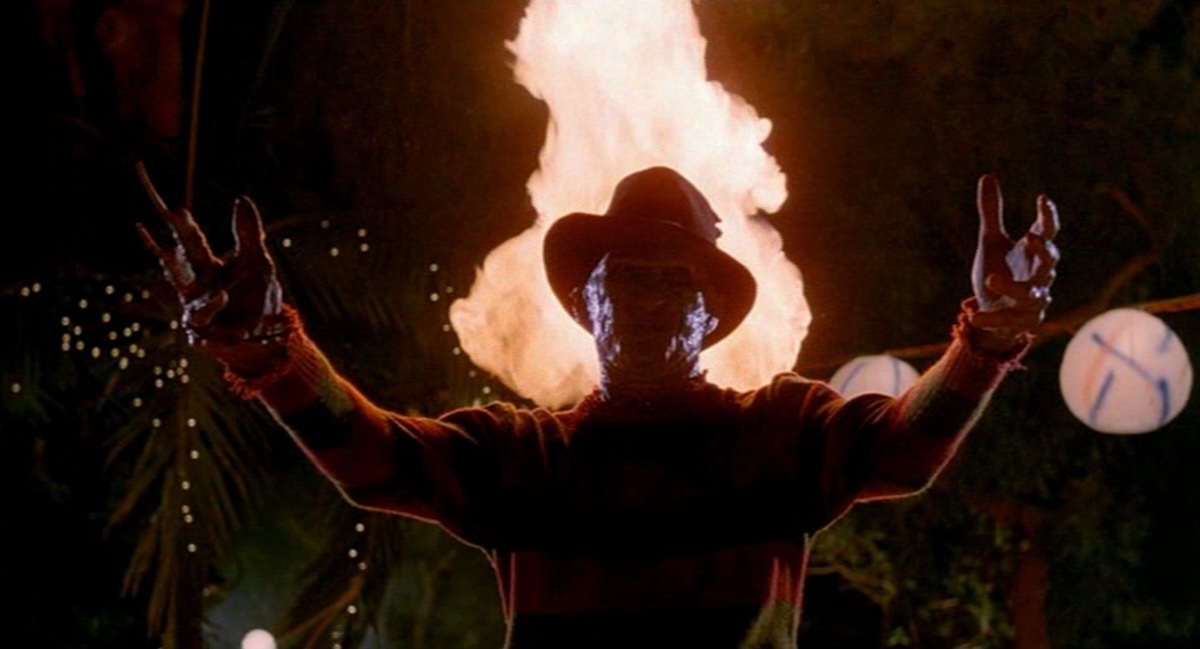

A teenage boy is haunted in his dreams by deceased child murderer Freddy Krueger, who is out to possess him in order to continue his reign of terror in the real world.
It’s one thing for opinions to shift when talking about a slasher film over the years, but the response to Freddy’s Revenge mirrors the times we live in. Now a quaint queer curiosity, “the gayest horror film ever”, sits comfortably on lists with I Saw the TV Glow (2024), The Boulet Brothers’ Dragula, and Don Mancini’s later Chucky work. But from the AIDS-terrified 1980s all throughout the rampant casual homophobic 2000s (Freddy is hit with an f-slur in Freddy vs. Jason), only now is calling this ‘gay’ no longer an insult.
There is no simple reading of this sequel. By that very metric, this also faces the scrutiny of being the first follow-up to Wes Craven’s critical and commercial 1984 horror darling. New Line Cinema in their infinite wisdom hired Jack Sholder, who had directed Alone in the Dark (1982) for them and was currently editing trailers, bought David Chaskin’s debut screenplay while he worked in their 16mm distribution department, and didn’t rehire Robert Englund believing Freddy could be anyone in a rubber mask. They fixed that mistake after shooting one scene.
Defining Freddy’s revenge is difficult enough given the surreal dream logic of the first being so deliberately nebulous. Craven knew how to tell a story, but he wasn’t building a playground for others. The best thing Part 2 has going for it is that it came before Dream Warriors (1987) canonised the exact Freddy formula. Later sequels are great fun but become a copy of a copy of a copy. Freddy’s Revenge, for better or worse, is entirely unique.
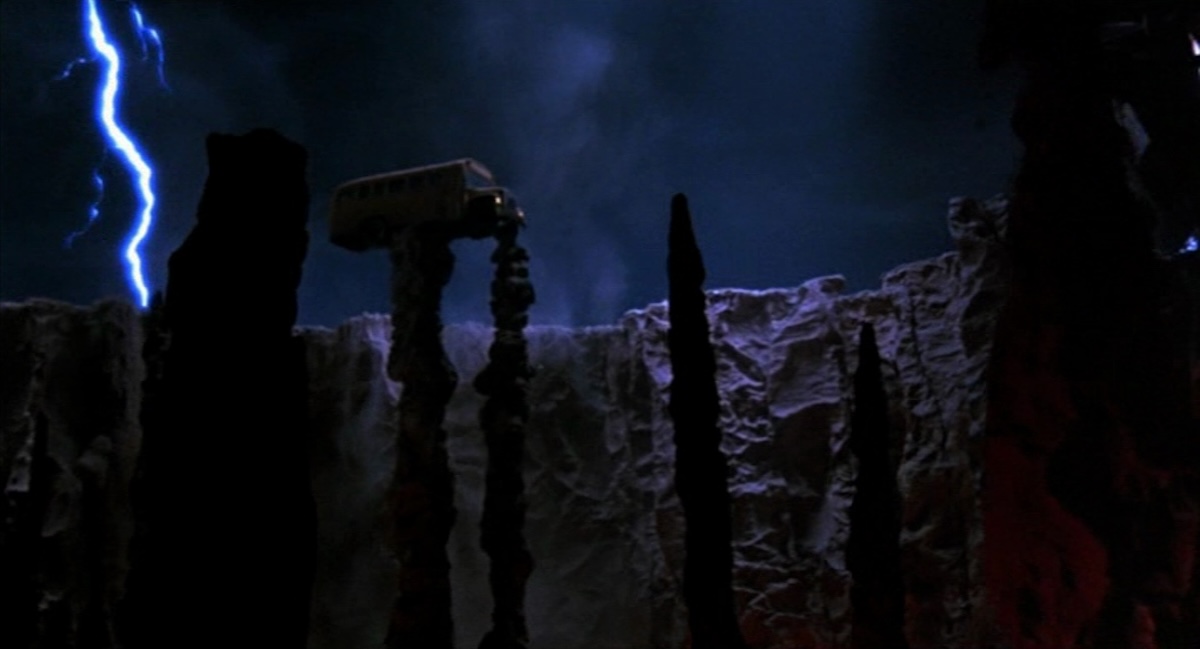
There are some strange attempts at making this a direct sequel. The new Final Girl, who’s a guy, Jesse (Mark Patton) moves into Nancy’s house, even her room, and his friend finds her diary which Jesse asks to read after hearing about fantasies of Johnny Depp. Patton should be applauded for his genuine on-screen torment: blood-curdling screams, drenched in sweat, visibly uncomfortable in his own skin. Adolescence itself is his living nightmare, making him a prime target for Freddy.
He’s not alone in his struggles; his friendship with Lisa (Kim Myers) is sweet though it has to turn into a relationship by the end. Lisa’s friends are pressuring her into “getting any”, as he’s the one holding out. His other friend, of sorts, Grady (Robert Rusler) pantses him at school and they wrestle in the dirt, tearing at each other’s clothes… Somewhere in all this, the film is tapping into the “repressed sexual angst that every teenager experiences” as Sholder understood it. That pressure leads to fear and Freddy Krueger thrives on manipulating even the most deep-rooted anxieties.
People overlook that Freddy didn’t actually talk much in the first, and while “prime time, bitch” is still a sequel away, he displays a pitch-black humour in abusing Jesse. Stroking his quivering mouth with those razor-sharp blades is a disturbing seduction as Freddy grooms the young man for possession. S&M culture is haphazardly ventured through later on and perhaps deeper than any other entry is Freddy’s sadistic power trip examined right here.
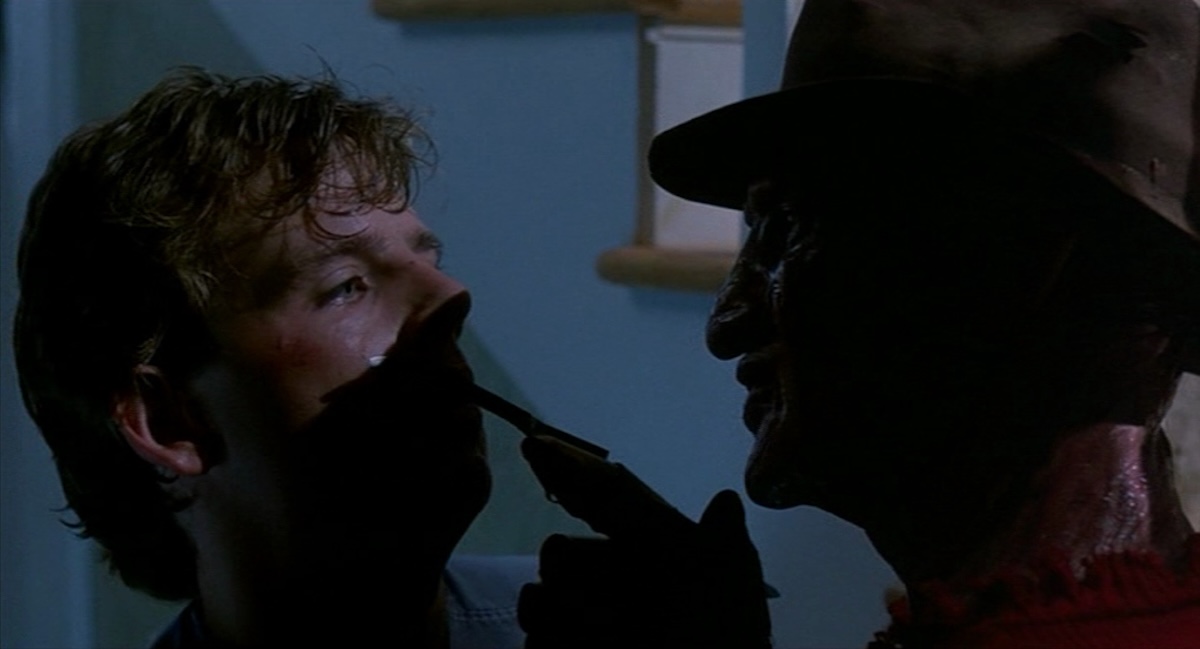
Later sequels got away with selling a child murderer to children, but Jesse standing over his little sister, bladed glove in hand, sweaty, shirtless… this is pointedly uncomfortable. Also, the only entry to elaborate on the familiar boiler room set dressing—Freddy’s resurgence heating up the entire house like his little pocket Hell on Earth. A parakeet combusts while attacking Clu Gulager, but otherwise a clever story element.
Taking over the scarred visage, first designed by David B. Miller, was Kevin Yagher and this might be tied with the first in the best Freddy has ever looked. An evolution, or devolution, Freddy is still horrifically seared but his cheekbones are sharper, his nose protracted, and his eyes are a hellish red and yellow. Like a skull wrapped in melting flesh, he’s even less human and borderline demonic. It’s hard to reconcile this with the shades-sporting goof and his Nintendo Power Glove; this spectre is mutating from his own insatiable evil.
This darkness pervades into the nightmarish kills. Being pounded by balls and having your bare ass whipped with a towel in the shower is unavoidably camp. But the blurring of whether this nightmare is fuelled by Jesse or domineering Coach Schneider (Marshall Bell) equally evokes punishment of their supposed lifestyles. As much as fans who comfort-watch this franchise hate to admit, a remorseless killer like Freddy likely would take advantage of internalised homophobia. The maturer complexities we should aspire to see after former humanities professor Wes Craven started the series.
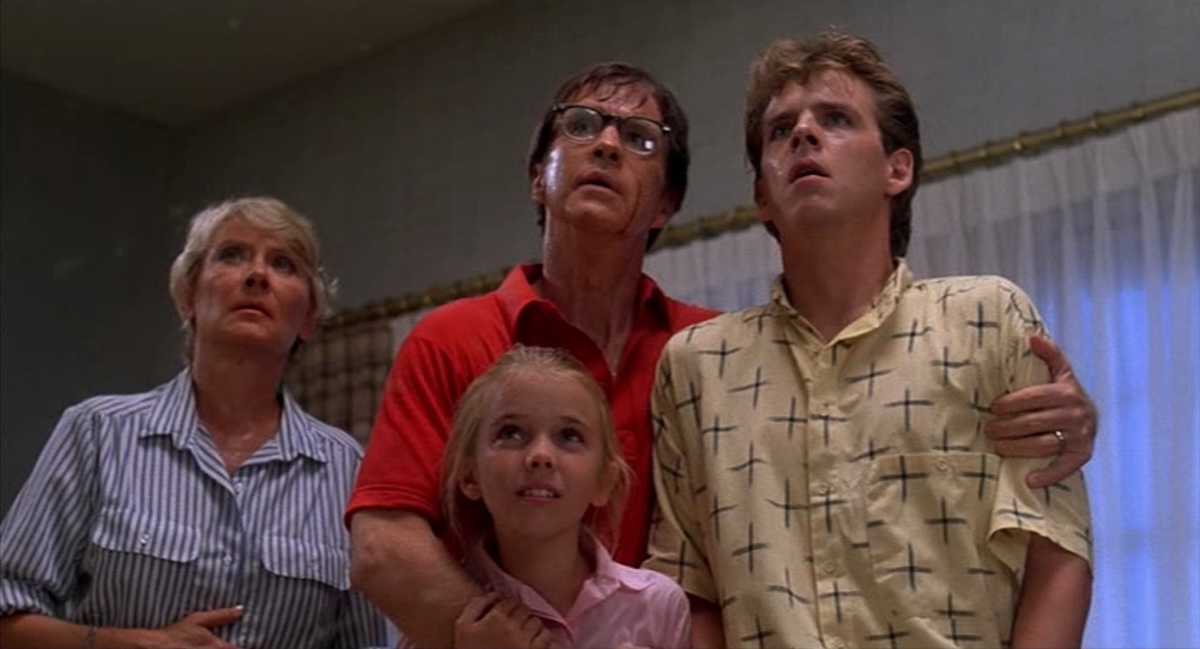
The second kill, with visceral effects by Mark Shostrom, opens with Freddy overcoming Jesse in graphic fashion. Razors bursting out of his fingertips, Freddy’s face bulging out of his chest, our lead reduced to a skin suit tossed aside. Contrast the actual murder of Grady with the brutally efficient glove piercing through him out of his door is light on guts or gore. All the while still emotionally resonant as Freddy places the blame on a blood-soaked Jesse. Listing nightmare kills is easy as these are the only two in a horror produced after Jason and Michael had already massacred their way into several sequels. Then there’s the exceedingly random poolside incident as Freddy enters our world and mindlessly slashes seven unnamed partygoers.
That makes this his highest, and most contested, body count in the entire franchise. Disputed not in numbers but just how or why he achieves this feat. Jesse tearfully confesses his reluctant culpability as “he owns me”, and with Lisa preventing her dad from shooting Freddy, the inference is they’re sharing the same body. Simply accepting the words of Bing Crosby in the credits, “The dream that was walking and the dream that was talking.”
Sholder has his own confession that he “had very little time to prepare” and that Freddy’s Revenge contained “a lot of special effects, none of which I knew how to do.” Working hard to produce a sellable sequel, Sholder admitted, “I simply didn’t have the self-awareness to realise that any of this might be interpreted as gay.” God only knows what he was thinking upon reaching the gay bar in the script. But that at least is clear-cut, and it would be far too easy to list the overwhelming innuendo-laden phrasing. The real conversation depends on how you interpret the messages therein, as even Chaskin relents, “there is nothing logical that can explain the level of homoeroticism in this movie.”
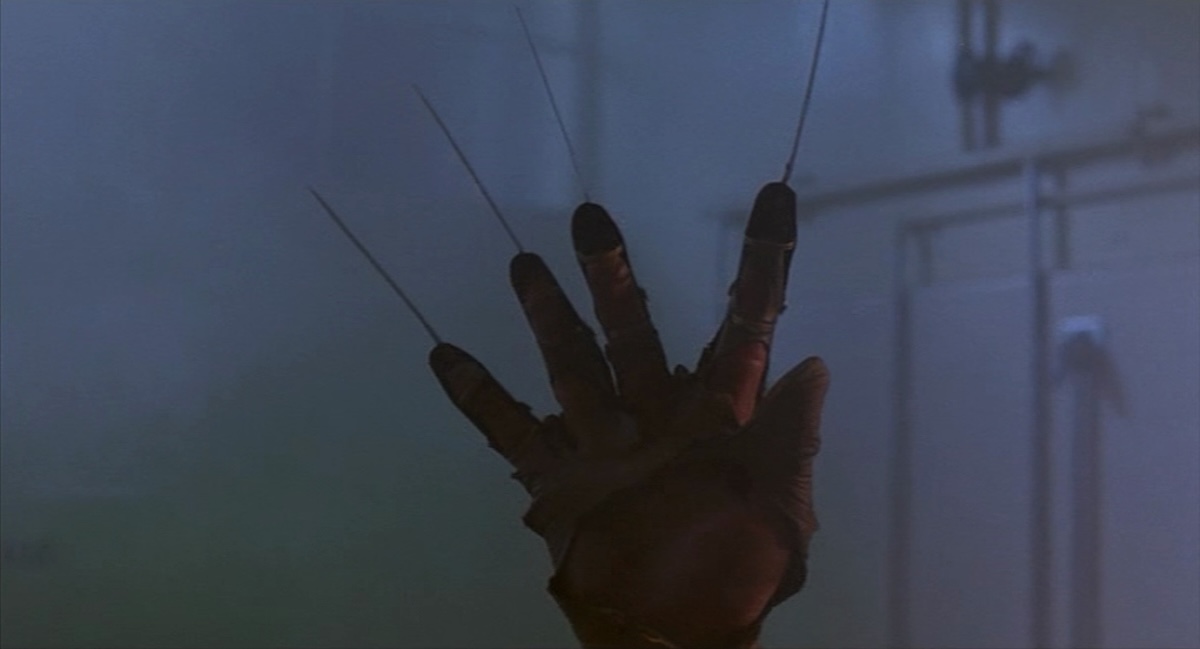
Freddy tries to come out during a heavy hetero make-out, forcing Jesse to sneak into Grady’s bedroom and tell him, “Something is trying to get inside my body.” That’s gay. Grady’s response being, “Yeah, she’s female and waiting for you in the cabana, and you want to sleep with me” is bewildering. There’s either some sex ed confusion or Lisa’s got a reputation if she is trying to get inside Jesse.
Behind-the-scenes strife could colour any reclamation of this queer coming-of-age story. Over the years, Patton has accused Chaskin of consistently emphasising the gay undertones through production, arguing “it just became undeniable.” Claiming those in charge knew he was closeted himself, Patton felt pressured to blindly accept egregious rewrites that would put the spotlight on his real life. He’d go as far as curtly remarking, “Did you actually go to a freshman English course in high school? This is not subtext”, followed with the admission, “Nobody ever affected my confidence, the boys that threw rocks at me, nobody but this man did.”
Chaskin defended himself over the years with outright denial. There was no subtext, and Patton merely acted “too gay.” A quote to a reporter he also argues never occurred. The spotlight was shone and Patton retired from acting from 1989 to 2016. One reason he felt confident returning was participating in the 2010 documentary Never Sleep Again: The Elm Street Legacy; in which, Chaskin cheerfully altered the narrative, in a time where legalised gay marriage was sweeping the states, that he was bravely championing equality. Following the nightmarish aspect of Freddy, that “tapping into that angst would give an extra edge,” Chaskin argued Freddy’s Revenge is a societal reflection of how, “Homophobia was skyrocketing and I began to think about our core audience, adolescent boys, and how all of this stuff might be trickling down into their psyches.”
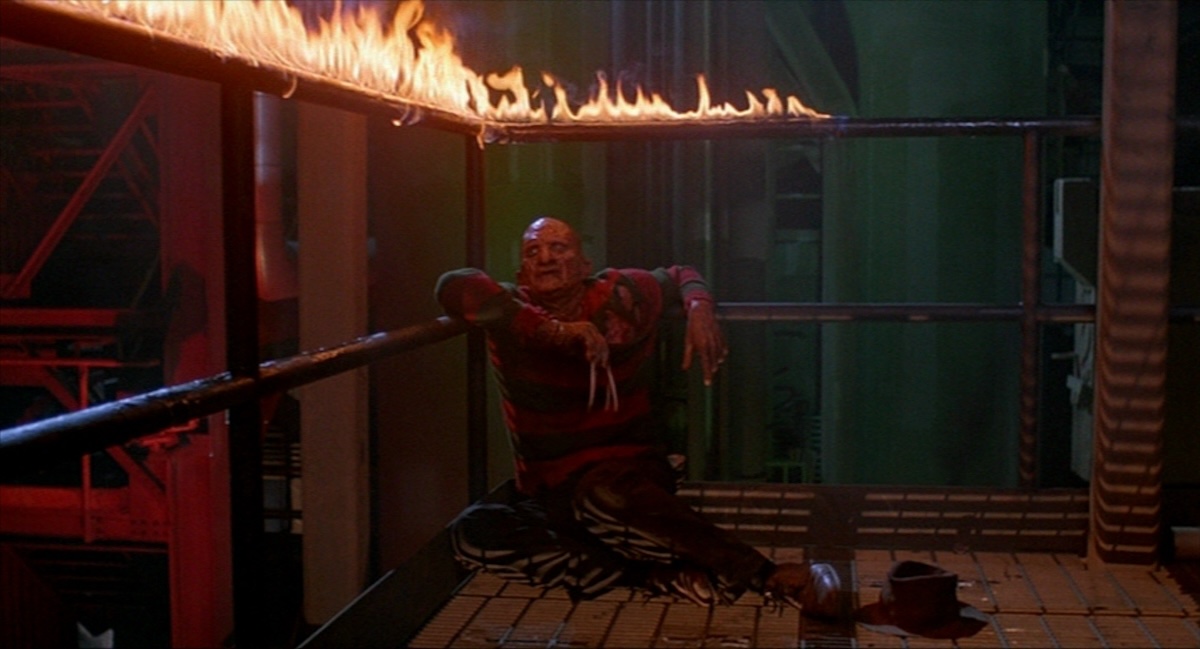
Reality rarely has a clean-cut three-act structure. Many oppressed people wait their entire lives for a happy ending. And with a queer reading, it’s hard to shake off disappointment with what coded message the screenwriter was attempting and which adolescent boys he’s representing. Lisa takes Freddy’s power away with a defiant declaration of love, allowing Jesse to break free and embrace the heterosexual relationship that so many men were distracting him from.
In the doc, Chaskin offers “they could just be friends after,” with Kim Myers aspiring to be “the Will and Grace of the horror genre.” In further extra-textual efforts, Patton wrote the unofficial Jesse’s Lost Journal in 2012, retelling the events with explicit homosexuality. Later in 2019, Patton produced and starred in the documentary Scream, Queen! My Nightmare on Elm Street, focusing on the enduring legacy of Freddy’s Revenge. Out and proud, Patton learns to celebrate that, “It’s something that happened along the line by serendipity.”
Once closeted people often look back with shock that their lives were so different in the past, and to a certain degree, I hope audiences rewatch Freddy’s Revenge with new eyes and appreciate a complicated film they so easily dismissed.
USA | 1985 | 87 MINUTES | 1.85:1 | COLOUR | ENGLISH


A psychiatrist, familiar with the knife-wielding dream demon Freddy Krueger, helps teens at a mental hospital battle the killer who is invading their dreams.
Director Chuck Russell was also under the now familiar stress of many directors involved in big-budget franchises, particularly as New Line were adamant this entry would cement the perfect formula for Freddy going forward. “Sleep. Those little slices of Death. How I loathe them” opens the film, promising the vivid despair and yet taunting a culture clash of high and low art. Craven was a college teacher and infused his Elm Street with real history and Russian philosophy, but he was also making horror movies to make audiences jump out of their seats. You don’t follow up Edgar Allen Poe with glam metal Dokken without a little self-awareness.
If this was the entry where you fell in love with primetime Freddy, continue reading our full Dream Warriors retrospective.
USA | 1987 | 96 MINUTES | 1.85:1 | COLOUR | ENGLISH


Freddy Krueger returns once again to terrorise the dreams of the remaining Dream Warriors, as well as those of a young woman who may be able to defeat him for good.
Who earns first billing before the title card? Robert Englund. To paraphrase the classic MTV slogan, audiences were chanting “I want my Freddy!” Renny Harlin went as far as calling him the James Bond of the series, “because of that popularity, I’m faced with showing Freddy in a more heroic light. People will still fear him, but they will also be cheering him on.” Freddy under Wes’ creative vision was the iconic Connery, but Dream Master goes full slide whistle car flipping The Man with the Golden Gun (1974). Freddy does drag, Freddy’s job is beach, Freddy is reborn using flaming dog piss. The series begins to resemble Funny Games (1997) in how utterly helpless the teens are because the will of the audience is fuelling Freddy to win.
Are you ready for Freddy? You oughta be by now, but be sure by continuing to read our full Dream Master retrospective.
USA | 1988 | 93 MINUTES | 1.85:1 | COLOUR | ENGLISH


The pregnant Alice finds Freddy Krueger striking through the sleeping mind of her unborn child, hoping to be reborn into the real world.
When Alice is not thinking aloud to blatantly set up the story beats, the real questions are left oddly unexplored. That the dream child is Alice’s is clear, but less so how a foetus is portrayed by an 11-year-old child who can speak. He has abandonment issues and hasn’t even been born yet! This dark and ‘controversial’ discussion ends up like a Christian made-for-TV special where Alice is guilt-tripped into keeping the baby… by her own baby. Get Freddy a visit with the Pope—he’s just proven life begins at conception.
How can an Elm Street sequel aspire darker and end up sillier? Find out by continuing to read our full Dream Child retrospective.
USA | 1989 | 90 MINUTES | 1.85:1 | COLOUR | ENGLISH
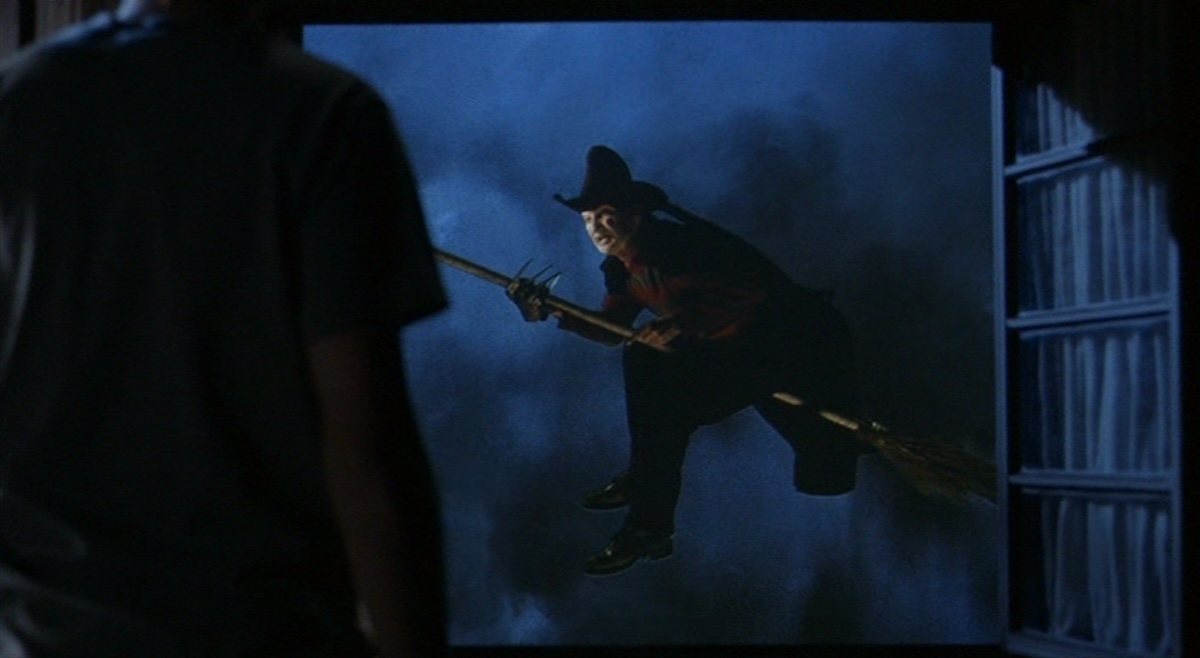

Freddy Krueger returns as psychologist Maggie Burroughs, tormented by recurring nightmares, meets a patient with the same horrific dreams.
When the fifth film brought in less than half the profit of the fourth film, New Line Cinema finally admitted there couldn’t just be a sixth film ignoring the dwindling income. Their first two Critters films had done well, and the family-friendly Teenage Mutant Ninja Turtles (1990) was raking in $200M. Founder Bob Shaye put it plainly: “it was time to move on.” ‘The House That Freddy Built’ was now evicting their former breadwinner.
Two prospective ideas could right the ship of their future and one involved an up-and-coming New Zealander named Peter Jackson. It wasn’t The Lord of the Rings (2001-03) quite yet, but he got his foot in the door pitching ‘The Dream Lover‘. Springwood’s desensitised teens were now drugging themselves to sleep to chase down a decrepit Freddy like the homeless beating in A Clockwork Orange (1971). New Line instead went with producer Rachel Talalay championing to direct fellow writer/producer Michael De Luca’s script after giving it the marketable title of Freddy’s Dead: The Final Nightmare.
De Luca is now the multiple Academy Award nominated CEO of Warner Bros. Pictures and oversaw a similar approach with The Conjuring: Last Rites (2025). Promoting the last chance to see beloved characters on the big screen, this worked recent wonders by breaking records for the biggest global box office opening of a horror. Did they learn this trick from Freddy or was he already dead and buried?
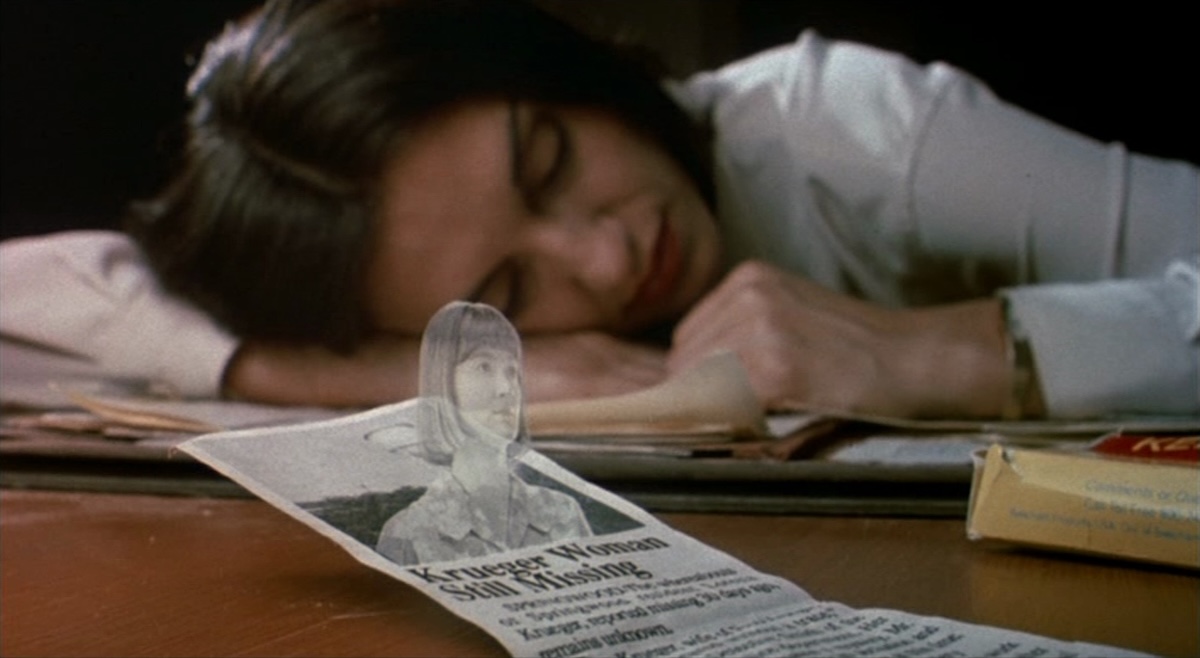
Freddy himself is feeling the fear of missing out. An opening computer graphic drops the wild lore that “mysterious killings and suicides wipe out entire population of children and teenagers” in the town of “Springwood, Ohio, 10 years from now.” This film is set in 2001, apparently. Freddy’s got a big surprise coming when he finally escapes the town. This latest addition to the dream demon’s circumstances is as perplexing as his fixation on 1428 Elm Street. The original title of A Nightmare on Elm Street was just that—an ordinary neighbourhood where the impossible happened. Local legend and nothing more. But in the blurring of reality and dreams, this convoluted mythology is canonised by our belief giving it power. Maybe “the dream people”, as Freddy woefully puts it, never existed until Yaphet Kotto implanted the idea in the minds of the people Freddy is feeding on.
That’s already putting too much thought into a sequel tossing out the barest attempt as a grand finale. Even setting up nightmares is bereft of imagination: introducing the cast with their singular defining features of video games, martial arts, and hearing aids. Even the climactic 3D glasses and pipe-bomb are haphazardly showcased. Subtlety is a lost art form as Doc (Kotto) conveniently works at this halfway house and studies the power of dreams. He makes the most of his PhD coming up with the cerebral strategy of blowing up these ancient demons with said pipe-bomb.
The youth shelter is a great location for a NOES sequel as the parents nor police care about dumping children off for the “bleeding hearts.” Conversely is the childless Springwood with grief-stricken parents struggling to carry on with life. A shame we drift through locales rather than anchor down like the psychiatric hospital of Dream Warriors. Moments like the giant fold-out map scrawled with “YOU’RE FUCKED,” or the school chalkboard with the delirious history lesson of “Freddy kills Elvis?” are all cursory entertainment. Putting any thought behind the fun leads to ruin like the abandoned house transforming into another abandoned house, which happens to 1428 Elm Street. We know that’s Nancy’s house but why is that a trap for the kids who’ve never been here?
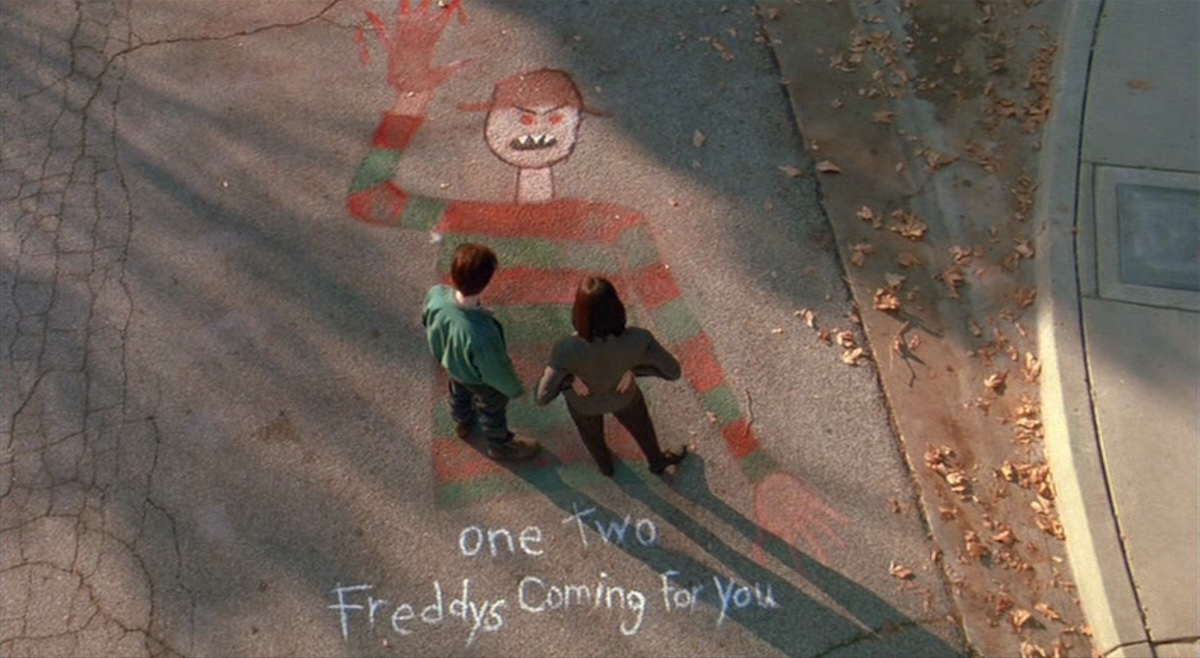
Lead kid John Doe (Shon Greenblatt) tries to voice the audience’s excitement by literally exclaiming story beats. They shouldn’t express shock that “Freddy had a kid!” when this is the very moment they’re learning who Freddy even is. And how does he conclude their friends are in danger? Is he reading the script like Heather Langenkamp in New Nightmare? The first film establishes the threat of nightmares in the very first scene. An ever-encroaching dread in the characters: Don’t. Fall. Asleep. But the last film confuses itself in trying to efficiently skip repetition—these characters all happily fall asleep with no idea there’s even a threat. There’s zero tension in this horror film.
But this isn’t a horror film. It attempts to be horror-comedy, but leans so egregiously into the latter that Robert Englund considered Freddy Krueger the new Bugs Bunny. When he’s not performing The Wizard of Oz (1939) homages or smacking Johnny Depp with a frying pan, he does succeed in a few last murders. Ain’t he a stinker? A cotton bud in one ear and out the other is Mad Magazine self-parody, but Freddy does take great advantage of Carlo’s (Ricky Dean Logan’s) disability to memorable results. Reversing his problem with an ultra-sensitive mutant hearing aid is clever, and literal pin-drops and his razor-fingers on a chalkboard is delightfully mean-spirited. The best kill of the film is soon followed by the worst kill of the franchise.
The latent homoeroticism of Freddy’s Revenge reduced that film to a joke for many years. There is no eventual reclamation of Freddy “playing with power!” No matter how much Robert Englund boasts they were ahead of the curve with video game culture, they were behind the curve at the time. The Nintendo Power Glove was released in 1989 and discontinued in 1990—it was already a dated reference. Remember these characters have no knowledge of Freddy, and yet have absolutely no reaction to Spencer (Breckin Meyer) bouncing around and launching his head through the ceiling. Lezlie Deane was proud to say this role helped her process her own troubled childhood, but the less said the better with Tracy confronting the repressed trauma of her sexually abusive father, chased with “kung fu this, bitch!”
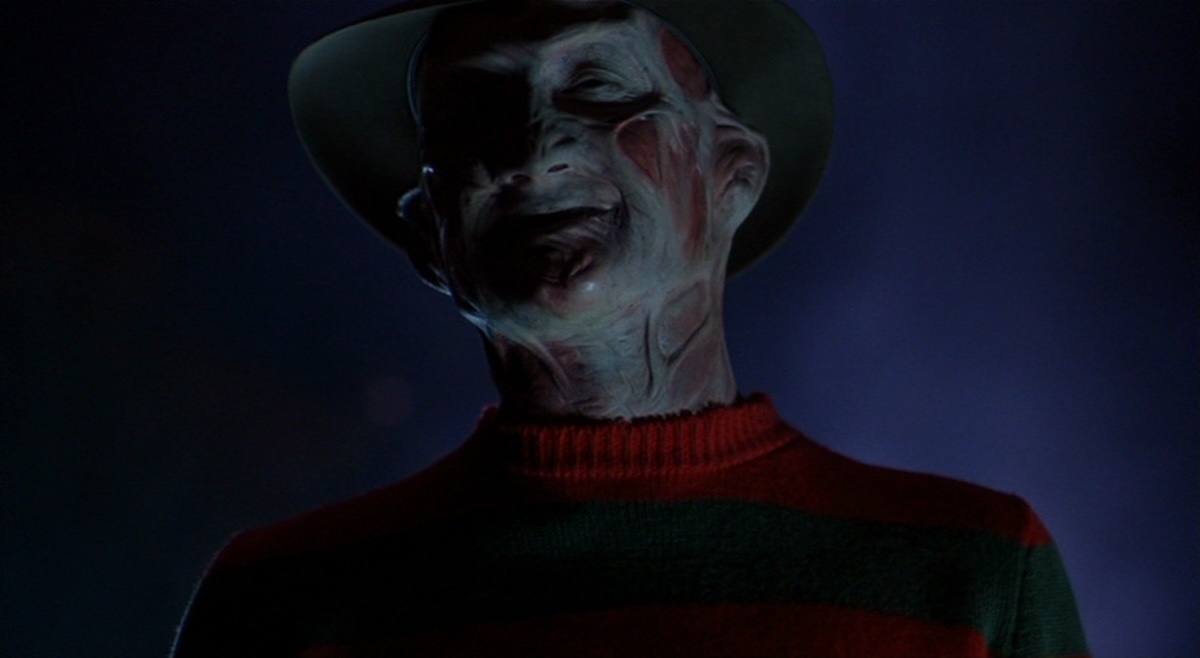
If Robert Englund hadn’t returned for two more sequels, I’d have thought he was sick and tired of putting on this make-up. The burnt face is one step above store-bought Halloween mask with noticeable creases and folds where the rubber hasn’t been applied. Either that or old man Freddy has a bad case of turkey neck. A performance is more than skin deep but Freddy gurning like Al Lewis doing a big Grandpa Munster smile encapsulates the entire film. Toothless.
Even on the rare chance it bears a baby tooth, it’s frankly more a film you laugh at than with. Talalay has hands-on producing experience on the first four NOES films, and would later display far more confidence in directing Tank Girl (1995) and a slew of great television. Her direction of one of the best Doctor Who episodes, “Heaven Sent“, is an incredible nightmare experience even non-fans would be floored by. You can have fun, like sequels had done, opening with a Friedrich Nietzsche quote and then “Welcome to prime time, bitch—Freddy Krueger.” An expected response is, “but Freddy isn’t scary anymore, he has to be funny,” but the comedy is as half-baked as the horror. This last-ditch attempt is like modern-day Ricky Gervais shouting “religion!” or Peter Kay yelling “garlic bread!” This ‘new’ material is a bitter remembering of the glory days.
The worst aspects lie in the foundation, like it never made it past the first draft. Rather than deal with the usual piling up of dead teenagers, there’s a new nonsense mystery as Doc surmises: “he erased them.” But is he only doing that now? Surely Springwood would’ve always been childless if they never existed. Doc also arbitrarily repeats the hat trick from the original to discover the way to make sure Freddy’s dead… by doing something we know didn’t work. In that same scene, Freddy listing off past defeats is summarily half-hearted since he only lists three.
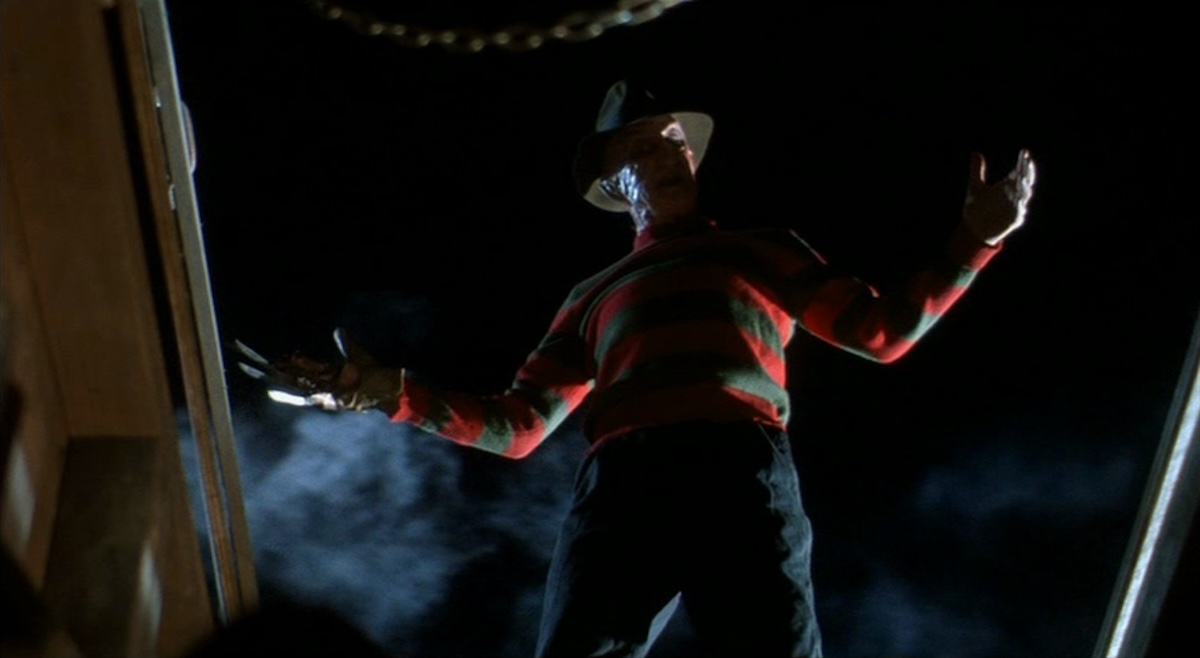
The last 10 minutes are in 3D, forcing many cinema-workers to explain when to put them on. Put them on when she does as she goes to sleep. But they disappear and she wakes up without them, so take them off? Hang on, they’re still waggling stuff at the camera so pop them back on a bit longer. Child Freddy is bullied by classmates, teen Freddy gets lashed by Alice Cooper, and animatronic dream demon fishes swim around his brain.
Freddy calls them “the dream people who gave me this job,” but they sure don’t respect their employees as Freddy gets his ass beaten with a metal pipe. A fitting death for any iconic slasher, like Michael in Halloween 6 (1995). Maggie pins him to the wall with throwing knives and shuriken, the cast and crew must’ve been rushing to wrap as this is inexplicably happening in the real world. A pipe-bomb blows him up and the dramatic cut to credits after “Freddy’s dead” tries to trick audiences with a franchise montage to leave with a smile.
This was certainly not The Conjuring: Last Rites. On a budget projected as high as $11M, Freddy’s Dead didn’t even break records within the franchise as the $34.9M box-office left this the fifth highest-grossing film in the series. A retrospective that might read particularly harsh, as Homer remarks, it’s easy to criticise, and fun, too. This isn’t my first viewing, nor my last, and there’s no Englund-led NOES worth skipping. It’s not a fitting finale, as more effort was put into the marketing; Freddy’s funeral was even a televised event with the cast and crew attending a staged service for the press! Talalay was quoted answering if Freddy would ever return with “no, no, no, no, no, NO.”
Three years later, he was back.
USA | 1991 | 89 MINUTES | 1.85:1 | COLOUR | ENGLISH
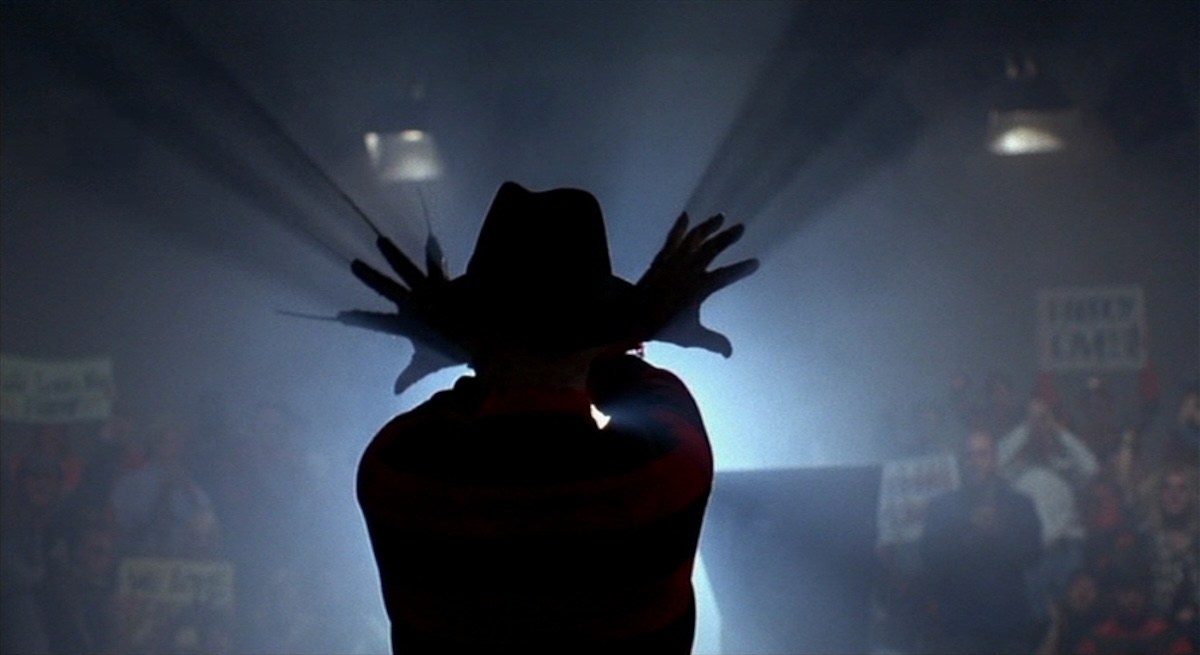

A demonic force has chosen Freddy Krueger as its portal to the real world. Can Heather Langenkamp play the part of Nancy one last time and trap the evil trying to enter our world?
It all started with a phone call. Not Scream (1996), not New Nightmare, but Wes Craven phoning Bob Shaye out of the blue to bury the hatchet with an old friend. Shaye had been working towards this since hearing of Craven’s grievances towards the franchise by always inviting him to check in on each and every sequel. Some merchandise profits never hurt, either. Freddy’s Dead had declared no more nightmares and Wes agreed there was no way to ever make sense of following up the convoluted lore. Instead, he conceived a far more audacious angle. What if Freddy was dead? What if Freddy was never real? What if this new nightmare was something else entirely?
After the Goo Goo Dolls opening last time, we’ve gone full circle to a familiar Charles Bernstein motif over the construction of a bladed glove… But then he cleaves off his own hand for a robotic prosthetic! Wes Craven knows how ridiculous Freddy became because he’s calling cut on screen for his latest directorial venture. New Nightmare goes meta with a story about the making of a new NOES. Franchise veteran Heather Langenkamp (herself) watches on and shields her child’s (Miko Hughes’) eyes from the gory effects. It’s not real but Craven knows his work inspires nightmares. The rogue animatronic starts slicing and dicing the crew until Heather wakes up.
Being awake is just as dangerous with an earthquake rocking the Langenkamp household. Scarier still, it was already scripted when Los Angeles got rocked by a genuine 7.4 quake. The blurring of reality and fiction found the crew shooting B-roll of real-life damage seen in the film. A far more personal authenticity comes from Heather enduring calls from a stalker. This did happen and the real Langenkamp allowed Craven to incorporate it to fuel the performance and process some real issues. A strange case of horror films being innocent—her real stalker obsessed over the cancellation of her family-friendly sitcom Just the Ten of Us (1988–1990).
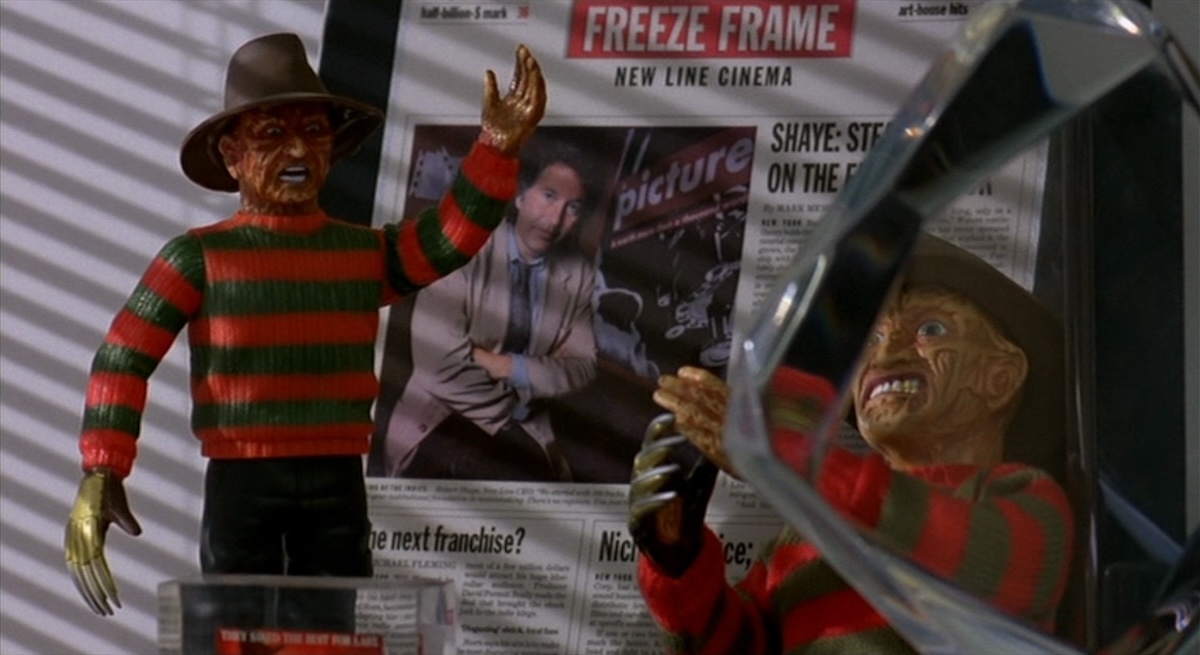
Craven tells this new nightmare of the scream queen aftermath. Overly familiar fans being invasive, interviewers asking if their kids watch these films, and the daily struggle of being anything other than a scream queen. Seven years on from her last appearance as Nancy and she’s still haunted by the role. Heather waking in the night as Bernstein’s original score creeps in twists into a different scare as the diegetic music leads her to her son watching A Nightmare on Elm Street. Craven reintroduces the human horror long missing from the franchise.
Robert Englund (Robert Englund) is still living large as the real star. His enthused performance pivoting Freddy Krueger from shadowy child murderer to pop culture superstar sold on lunch boxes for children. He surprises a talk show audience in full make-up, literally overshadowing Heather in her own interview. His brief appearance fits the intent of recasting the spotlight back on Heather. She still waits while he signs dozens of autographs. This effort by Craven was not lost on the real actress, “I was just really shocked that I was in the movie so much. [New Nightmare] is one of the only horror movies where the monster’s really in the background, at least until the end.”
The focus on our main lead keeps cutesy cameos to a minimum. Franchise stars attend the funeral of Heather’s husband (David Newsom) and John Saxon, having played her dad, is a hidden emotional weapon offering fatherly kindness. Him referring to Heather as Nancy in her dream gets me every time. Lin Shaye gets another cameo, and her brother (and New Line Cinema founder) Bob Shaye has featured in almost every NOES, now playing himself. Wes holds a more significant role, not acting so much as talking, and an actor playing him would lose the impact. Heather carries the scene reacting to his expository nonsense.
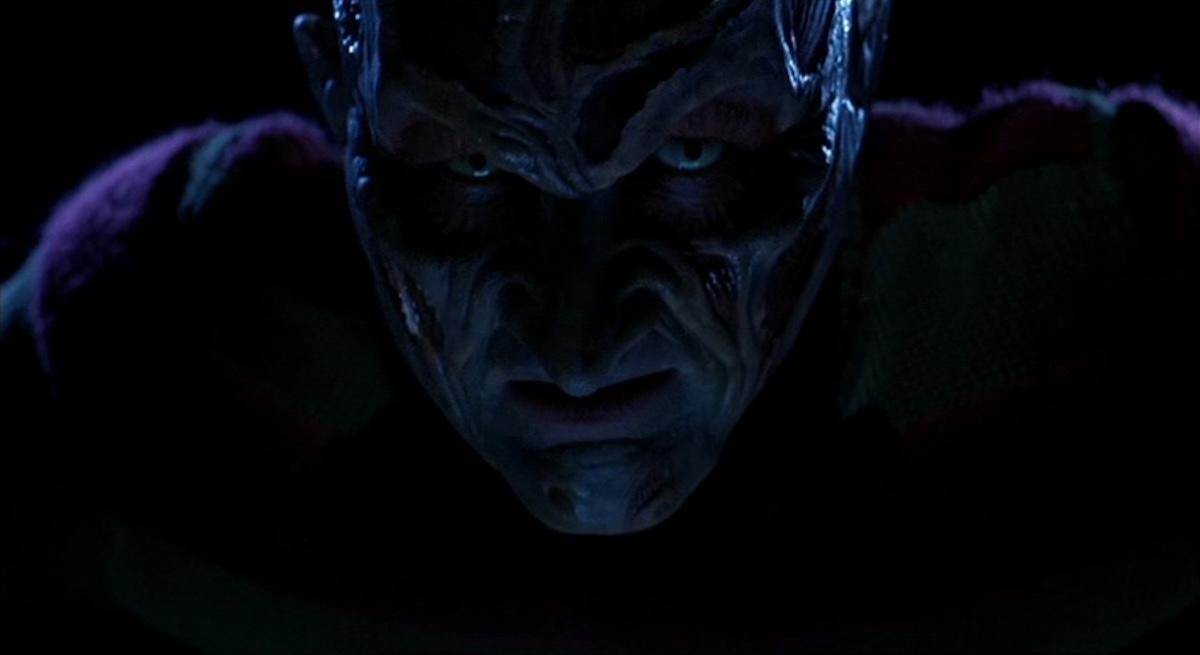
His concept of a ‘real’ demon taking the form of Freddy through thought-form is compelling but rides the line of preposterous with keeping it imprisoned within the franchise. It might be a hilarious overlooked joke that Wes invented a reason why New Line pumping out sequels was a good thing. Bob Shaye: thankless hero. Wes comes off a little too relaxed about all this, but his approach lulls us into the reveal that their entire conversation was pre-written into his developing script. Building up the demon is almost too effective as the set-up is better than the pay-off. Controversially, and paradoxical to Englund playing himself, Freddy Krueger is the weakest part of this Nightmare.
Langenkamp has such rich material to sink her teeth into, spiralling concerns of mental illness and passing schizophrenia onto her child; it almost should’ve been just that. With the immense pressure bearing down on her, Freddy makes his move in killing the babysitter (Tracy Middendorf) by dragging her across the ceiling in front of several witnesses. So enamoured by the startling new story, a return to recreating the big hits feels like a numbing novelty. Still better than the forgettable husband kill: a boring chest stab to be overlooked in a car accident.
The third act loses steam through a less than thrilling action-adventure sequence crossing the highway. Behind-the-scenes talks explain how complicated directing traffic was, but a floating Freddy in the clouds veers straight into sequel territory with effects trumping emotion. I find great merit in the storytelling, but as a conventional horror, I concede with Entertainment Weekly’s Owen Gleiberman that, “the movie succumbs to a kind of sterile inertia. Two long, slow hours of earthquakes, cracks in the wall, and other weary portents of doom.”
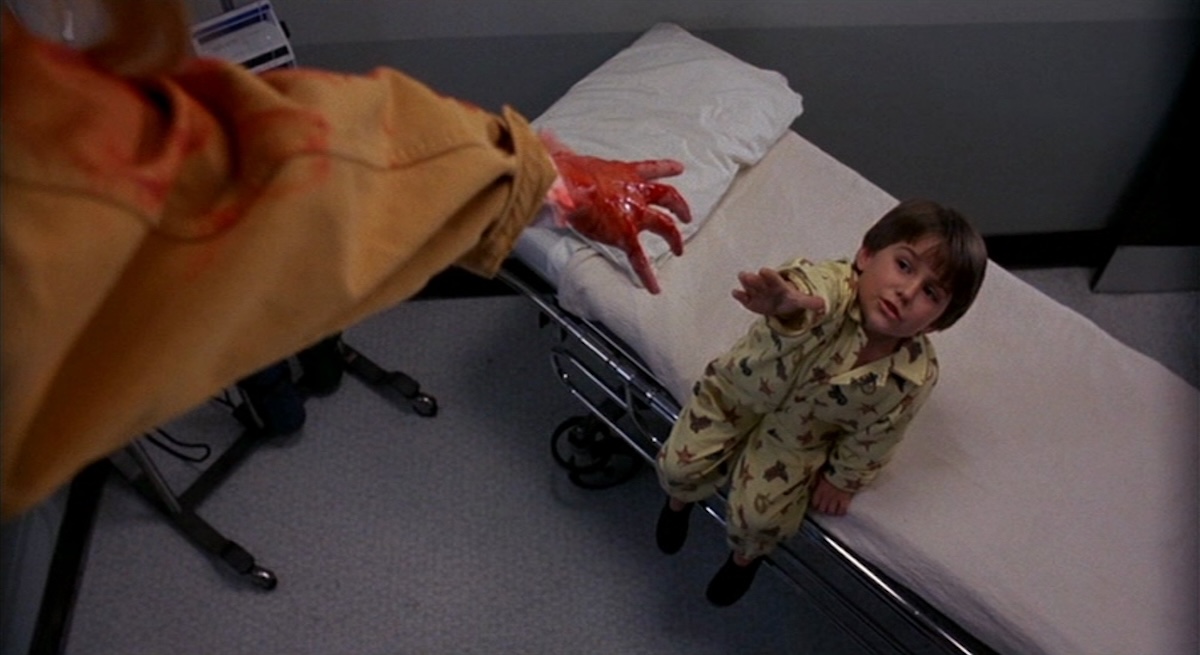
Freddy Krueger is credited as himself, but he isn’t quite himself. The latest look builds upon Kevin Yagher’s Freddy’s Revenge demonic features with a skinned musculature revamp. Creepy enough, but I prefer crispy over rubbery. The fleshy bionic glove is never as distracting as his tight leather trousers, and the overcoat and military boots are more perplexing than imposing. The notion of some timeless entity feels at odds with the desperation of trying to look cool.
In another homage, demon Freddy rising out of the mattress is threatening, but then Nancy chases him down into a Hansel and Gretel pastiche. There’s serious and silly Freddy, and there’s Heather point-blank yelling “fuck you!” and punching him in the face. The moment is an emotional pay-off for our protagonist, but it makes our protagonist seem shockingly weak. Nancy does more damage to him in the first film with her Home Alone booby-traps, versus the little stab in the side that pains a dream demon in his own realm more than Ghostface.
Craven goes bigger with fire and destruction and an incredibly dated morphing explosion of Freddy’s head, but it all comes off so flat. Even the initial sense of scale with the ancient colosseum miniatures of his domain feels small as what little action is ineffectively choreographed in the cramped and disjointed sets. The dream realm should be labyrinthine but the last three or four sequels have all visited similar locales. None of them match the claustrophobic personal horror of Nancy’s own house becoming her prison. New Nightmare is the same bombastic Hollywood that Scream 3 (2000) veers into, which is ironic since it feels like Craven remembered how to do an effective intimate slasher horror with Scream. To quote Heather, “I thought Wes stopped doing scary movies.”
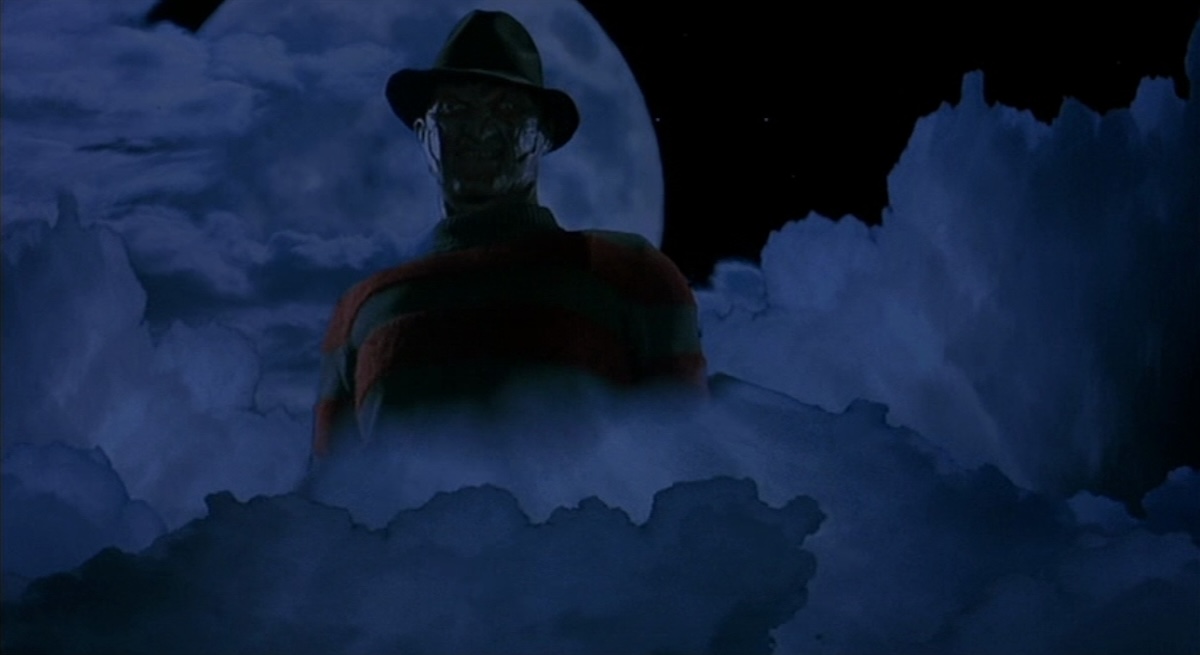
Like Freddy’s Dead, this was another final chapter of the franchise. With an $8M budget, it grossed $19.8M, and rests as the lowest-grossing Nightmare. In the Never Sleep Again doc, they speculate whether going against Pulp Fiction (1994) harmed their chances, but New Nightmare still received positive critical reviews and culturally since has endured as the favourite sequel for many fans. It may not have been named Last Nightmare, but the ending was clear this was a farewell to Freddy and Nancy direct from Wes.
Wild to think on similar legacy sequels such as Halloween H20 (1998) and Halloween (2018), the returning Jamie Lee Curtis was an entirely different woman than her teenage Laurie Strode. A Nightmare on Elm Street was considered dead as a franchise after one decade. In 1984, Nancy reacts to her new white streak of hair with “I look 20 years old!” Heather Langenkamp is only 30 in New Nightmare. Langenkamp and Craven never did return but Englund relished the role enough to reprise it for Freddy vs. Jason (2003) and as late as 2018 in the 1980s-set sitcom The Goldbergs. Together, they’ve relived that interview many more times and to this day celebrate the franchise. If not for their own sake, but to remember Wes. Like keeping the demon at bay, these characters retain a sense of immortality by rewatching these films. That means the nightmare never ends, but also the good times last forever.
USA | 1994 | 112 MINUTES | 1.85:1 | COLOUR | ENGLISH


Reviewed by Dan Owen.
A Nightmare on Elm Street fans have been poorly served by home video releases, at last in terms of packaging quality and artwork. Only a 1990s VHS box set delivers something worth displaying proudly on your shelf , as the spine of each videotape combined to reveal an image of Freddy with his arms outstretched across the seven movies.
The extant Blu-ray Collection box set of Nightmare’s 1–7 (none of these box sets include Freddy vs. Jason) is a fantastic bargain, but the packaging was generic and lacklustre, so Freddy-heads could only watch in jealousy as slasher rivals Jason Voorhees and Michael Myers got deluxe box set editions of all their movies. The Shape even beat Krueger to 4K. But has that sorry situation been rectified by Warner Bros.’s new release of Nightmare’s 1–7 on 4K Ultra HD?
Certainly, the two packaging options are a huge improvement. First, there’s an expensive Steelbook (£199 RRP) box set designed to look like Freddy’s striped jumper, with embossed and debossed detailing, where each of the seven film’s Steelbooks are adorned with their original one-sheet poster art. But there’s also a cheaper (£99 RRP) 4K Blu-ray package where every film’s kept inside a thick plastic snap case (inside a slip cover), and the external artwork is a more generic but stylised red-and-black image of Freddy wielding his glove from NOES4.
In terms of Special Features, most of the previous DVD and Blu-ray extras have been ported across for this new 4K box set. However, there are notable omissions — like Constantin Nasr’s 2012 documentary Fear Himself: The Life and Crimes of Freddy Krueger; the “It’s a Miserable Life” and “Killer Instinct” TV episodes of Freddy’s Nightmares (1988–1990); the Fat Boys’ “Are You Ready for Freddy” music video; Whodini’s “Any Way I Gotta Swing It” music video; and the theatrical trailers for all seven films.
There’s also NOES material from the 1996 Elite Entertainment Special Collector’s Edition LaserDisc (and Anchor Bay’s later VHS) that’s yet to be re-released since the mid-’90s, which contained deleted and alternate scenes from a workprint, still galleries, audio effects tests, and TV Spots. And lots more stuff besides the above, so this release sadly isn’t the definitive box set Freddy fans have always dreamed of.

All seven films have been remastered in 2160p/HDR10 (no Dolby Vision, alas) and the result is a worthwhile upgrade from the Blu-ray— mainly due to the benefits of high dynamic range (HDR) over standard dynamic range (SDR). NOES on Blu-ray was notoriously speckled with digital noise and used the colour timing from the DVD release, whereas this new 4K restoration (of both the Theatrical and Unrated Cuts) tightens the film grain, especially during darker moments, and the colours feel more natural. It’s a definite improvement.
However, the audio is where the 4K upgrade comes into its own, as we’re treated to a new Dolby Atmos track —with a restored DTS-HD 2.0 Master Audio track if you want the “Original Theatrical Audio”. The Atmos mix does feel louder and more rounded to my ears, but it’s great that fans have a choice of aural experience.
Some DVD and Blu-ray extras haven’t been carried over, sadly, including the picture-in-picture option for the Focus Points, the Freddy’s Coming for You Trivia Challenge interactive game, the Fact Track subtitle commentary, and the DVD-ROM materials which included a Script to Screen module.
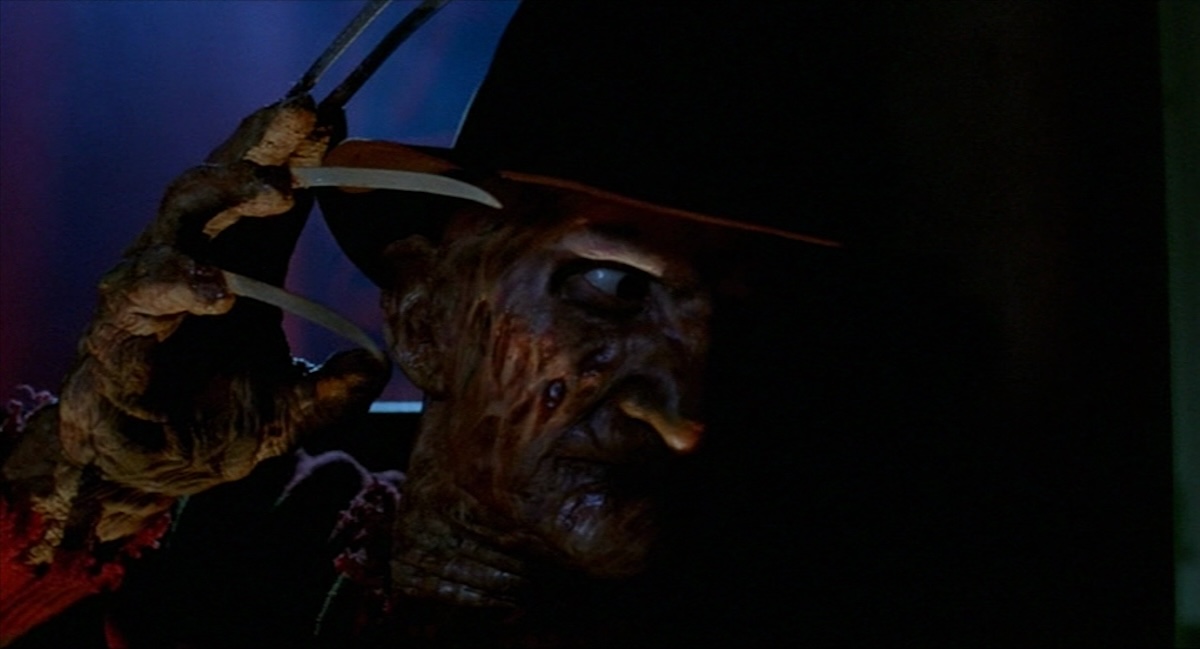
The 4K presentation of Freddy’s Revenge benefits from an excellent HEVC H.265 encode, derived from a new remaster of the film’s original elements shot on the Arriflex 35 BL camera. The 1.85:1 image is clean and detailed, with any softer, blurrier moments inherent to the original cinematography. The most significant enhancement is the balance of contrast and brightness, while colours are fuller and skin tones appear natural. This 4K version also much improves the clarity of colours in the pool party scene.
The audio options are Dolby Atmos and a DTS-HD 2.0 Master Audio track if you prefer something closer to the theatrical release, but the Atmos track is an improvement to my ears. The sound mix feels fuller and more expansive.

Although not as starkly improved compared to the other sequels, the video quality of NOE3 is better here with sharper details and a more refined grain structure. The HDR contrast and brightness are well-balanced with richly saturated colours, deep blacks, and improved shadow details.
Again, there’s a new Dolby Atmos track and DTS-HD 2.0 Master Audio mix, and I’d opt for the Atmos mix because it feels fuller and more immersive.
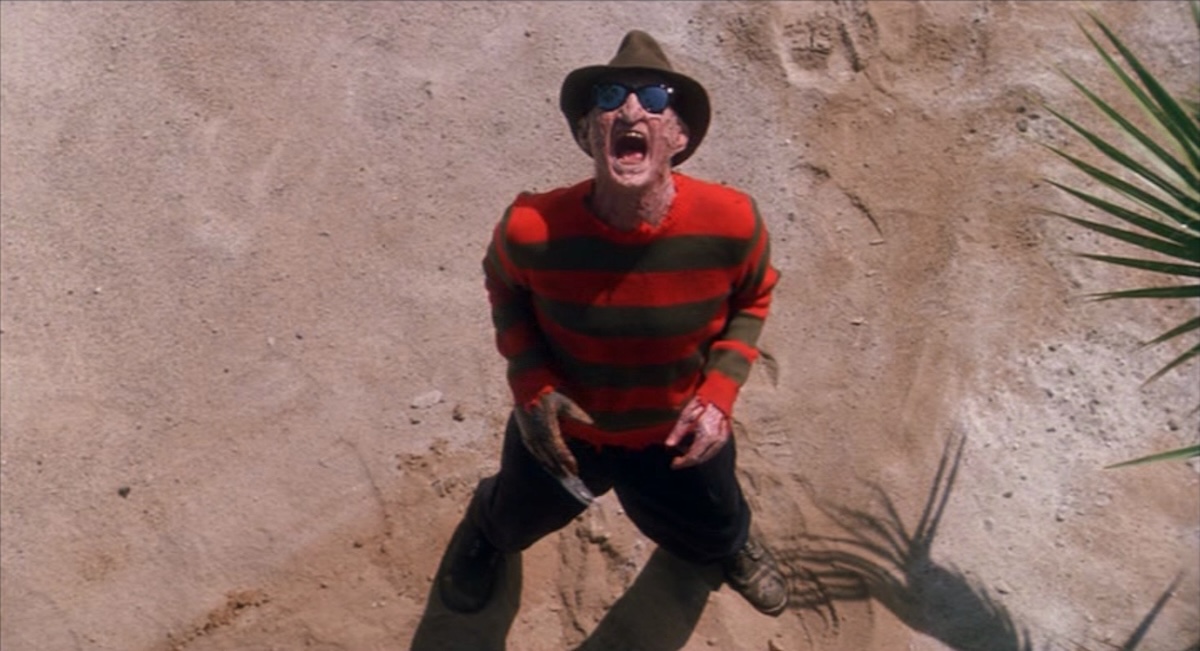
This is a vibrant new encode of the 35mm original film. Colours are fuller with more dynamic contrast to the dream sequences in 4K, while the contrast has been boosted with crisp specular highlights. The black levels deep but we can still always see everything in the shadows. There was also a centring issue with the scene in the junkyard on the previous Blu-ray, which has thankfully been fixed here. Against expectations, NOES4 is arguably the best visual remastering on the box set, presenting a gorgeous image it was a treat to see.
Dolby Atmos is again available with an alternate DTS-HD 2.0 Master Audio track — and as the first NOES movie to be released with a stereo track originally, the latter is better than the previous movie’s 2.0 mixes.

The 35mm celluloid grain’s been sharpened up thanks to 4K resolution, giving it a filmic aesthetic like never before. And while the contrast is generally subdued, all the dream sequences offer a dynamic shift full of gleaming whites. Black levels are deep with excellent shadow detailing too. Primary colours are rich and saturated, while skin tones are also natural and textured. Fans will also appreciate that you get the Unrated version of NOES5 on this set, as the MPAA originally cut some of the gore.
Again, Dolby Atmos and a DTS-HD 2.0 Master Audio mix is available, but the mixes aren’t as strong as NOES4.
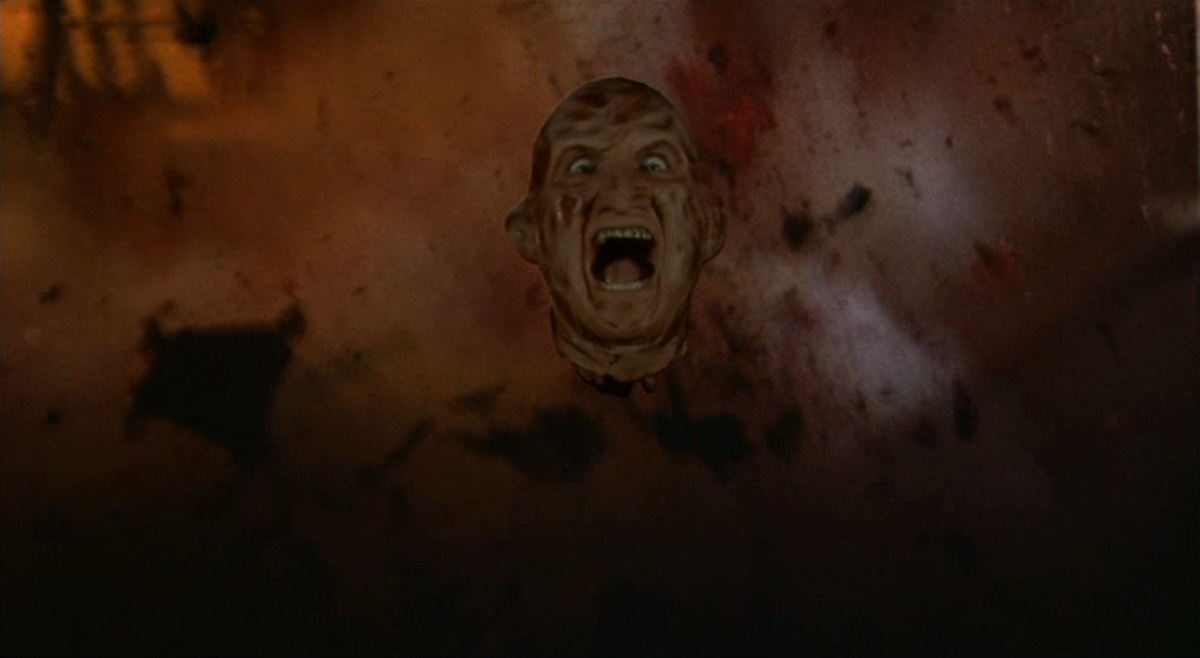
The picture quality is noticeably sharper and cleaner than on the prior Blu-ray, with better contrast and crisp highlights of the 35mm scanned print. Black levels are deep, details can be found in shadows, and the colour palette is generally an improvement with more realistic skin tones. The only downside is the quality does fluctuate a little, scene to scene.
This movie famously has a climactic 3D sequence (shot on Panavision Primo lenses), so you can wear packaged anaglyph cardboard glasses to see this. The old-school 3D obviously results in a dimmer image, but this new4K resolution does help to maintain details of the picture and the HDR10 aides with the contrast required to sell the 3D effect better. Shame there was no attempt to update that whole sequence for the modern 3D age, however.
The DTS-HD 2.0 Master Audio is actually preferable to the Dolby Atmos mix here, as the latter feels a bit off the mark with broadening and heightening the stereo sound.
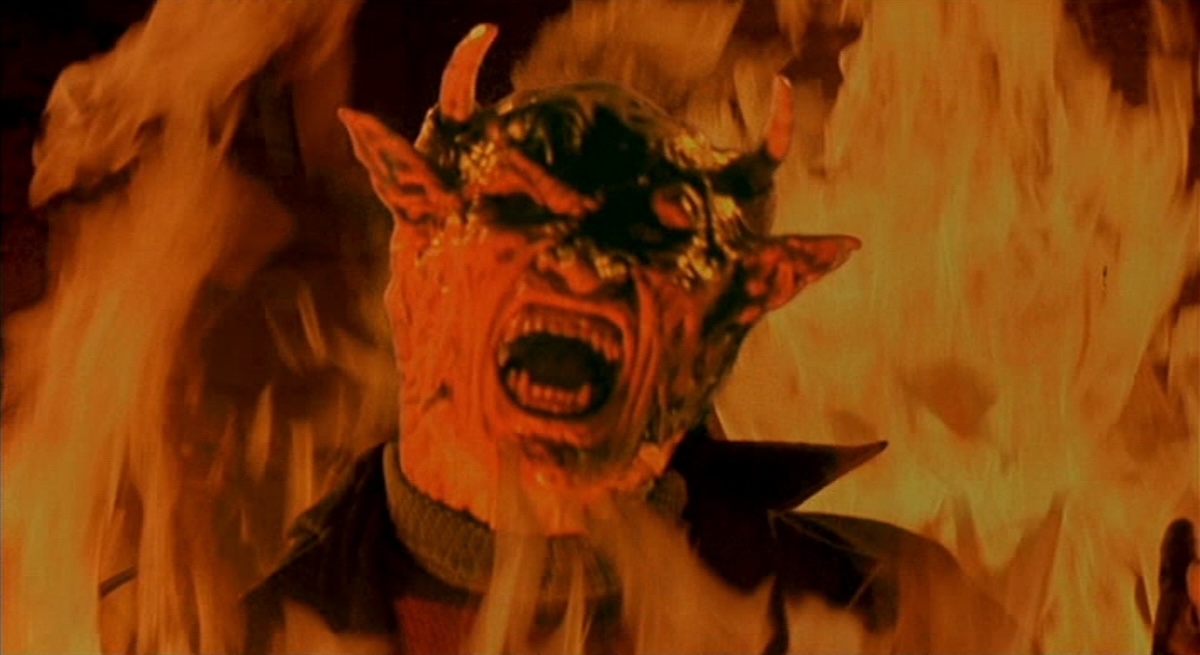
A new encode is a big upgrade over the Blu-ray, with natural grain that looks filmic and with much better contrast and inkier blacks. The early used of CGI is a little blurry, but it’s not a significant issue. As the most modern of the original NOES movies, it’s no surprise it looks the crispest and there’s not really much to complain about.
Dolby Atmos and DTS-HD 5.1 Master Audio are your audio options and both are great to listen to, but the added height and weight of the Atmos channels made it a little more pleasing to my ear. And the 4K box set’s only new special features are part of this particular movie…
directors: Wes Craven (Nightmare, New Nightmare) • Jack Sholder (Revenge) • Chuck Russell (Warriors) • Renny Harlin (Master) • Stephen Hopkins (Child) • Rachel Talalay (Dead).
writers: Wes Craven (Nightmare, New Nightmare) • David Chaskin (Revenge) • Wes Craven, Bruce Wagner, Frank Darabont & Chuck Russell (Warriors) • Brian Helgeland, Jim Wheat & Ken Wheat (Master) • Leslie Bohem (Child) • Michael De Luca (Dead).
starring: Robert Englund • Heather Langenkamp (Nightmare, Warriors, New Nightmare), Johnny Depp (Nightmare, Dead) & John Saxon (Nightmare, Warriors, New Nightmare) • Mark Patton, Kim Myers & Robert Rusler (Revenge) • Patricia Arquette & Laurence Fishburne (Warriors) • Lisa Wilcox (Master, Child) • Danny Hassel & Tuesday Knight (Master) • Whit Hertford (Child) • Lisa Zane, Shon Greenblatt & Yaphet Kotto (Dead) • Miko Hughes & Wes Craven (New Nightmare).
